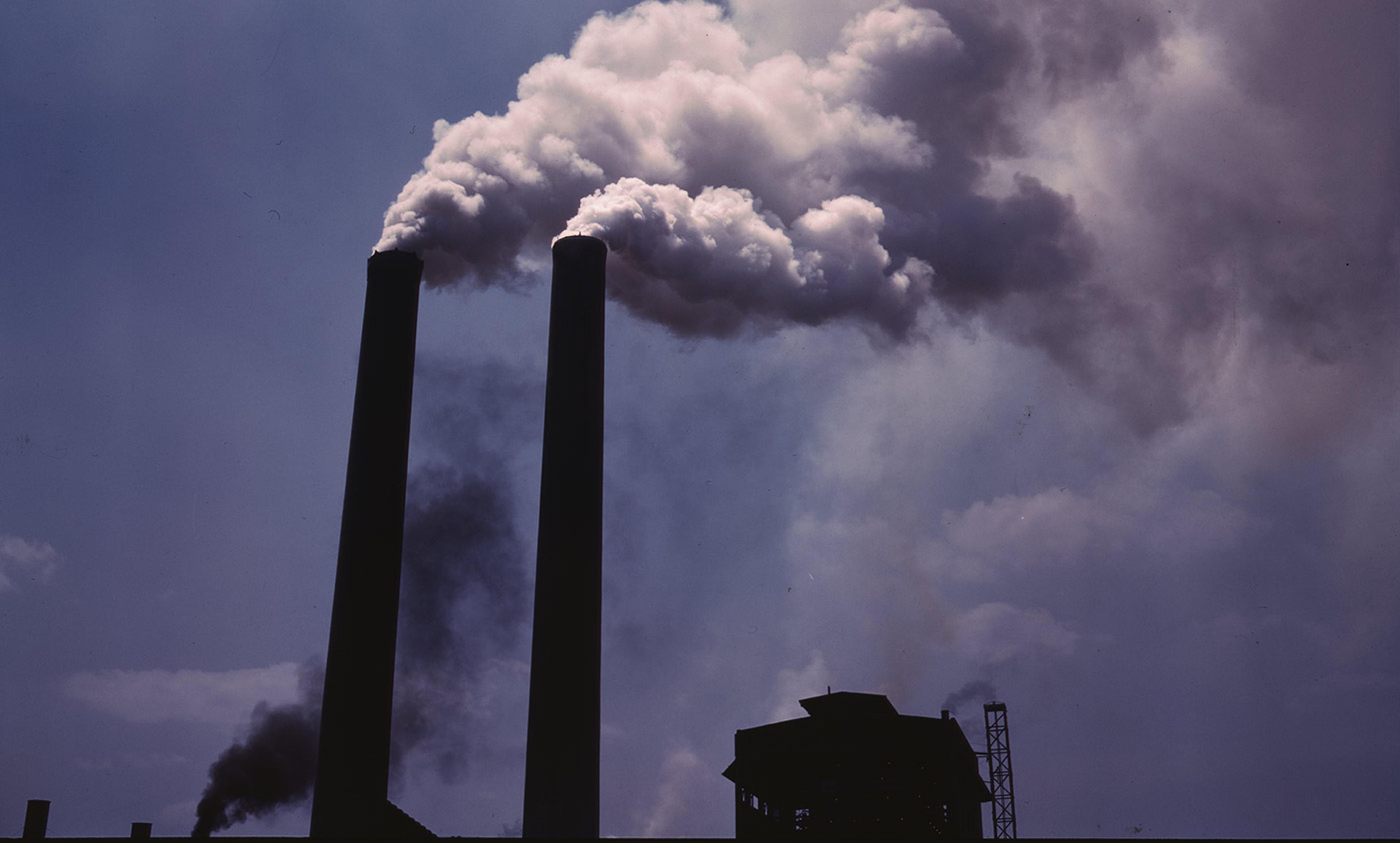
‘Smoke stacks’ (1942), Alfred T Palmer. Courtesy the Library of Congress
Climate change, caused by human activity, is arguably the biggest single problem facing the world today, and it is deeply entangled with the question of how to lift billions of people out of poverty without destroying the global environment in the process. But climate change also represents a crisis for economists (I am one). Decades ago, economists developed solutions – or variants on the same solution – to the problem of pollution, the key being the imposition of a price on the generation of pollutants such as carbon dioxide (CO2). The idea was to make visible, and accountable, the true environmental costs of any production process.
Carbon pricing could stabilise the global climate, and cap unwanted warming, at a fraction of the cost that we are likely to end up paying in other ways. And as emissions were rapidly reduced, we could save enough to compensate most of the ‘losers’, such as displaced coal miners; a positive-sum solution. Yet, carbon pricing has been mostly spurned in favour of regulatory solutions that are significantly more costly. Why?
Environmental pollution is one of the most pervasive and intractable failures of market systems (and Soviet-style central planning). Almost every kind of economic activity produces harmful byproducts, which are costly to dispose of safely. The cheapest thing to do is to dump the wastes into waterways or the atmosphere. Under pure free-market conditions, that’s precisely what happens. Polluters pay nothing for dumping waste while society bears the cost.
Since most energy in modern societies comes from burning carbon-based fuels, solving this problem, whether through new technology or altered consumption patterns, will require changes in a vast range of economic activities. If these changes are to be achieved without reducing standards of living, or obstructing the efforts of less developed countries to lift themselves out of poverty, it is important to find a path to emissions reduction that minimises costs.
But since pollution costs aren’t properly represented in market prices, there’s little use in looking at the accounting costs that appear in corporate balance sheets, or the market-based costs that go into national accounting measures such as Gross Domestic Product (GDP). For economists, the right way to think is in terms of ‘opportunity cost’, which can be defined as follows: The opportunity cost of anything of value is what you must give up so that you can have it. So how should we think about the opportunity cost of CO2 emissions?
We could start with the costs imposed on the world’s population as a whole from climate change, and measure how this changes with additional emissions. But this is an impossibly difficult task. All we know about the costs of climate change is that they will be large, and possibly catastrophic. It’s better to think about carbon budgets. We have a good idea how much more CO2 the world can afford to emit while keeping the probability of dangerous climate change reasonably low. A typical estimate is 2,900 billion tonnes – of which 1,900 billion tonnes have already been emitted.
Within any given carbon budget, an additional tonne of CO2 emitted from one source requires a reduction of one tonne somewhere else. So, it is the cost of this offsetting reduction that determines the opportunity cost of the additional emission. The problem is that, as long as the CO2 generated ‘disappears’ into the atmosphere (and, eventually, the oceans), corporations and households do not bear the opportunity cost of the CO2 they emit.
In a properly working market economy, prices reflect opportunity costs (and vice versa). A price for CO2 emissions high enough to keep total emissions within the carbon budget would ensure that the opportunity cost of increasing emissions would be equal to the price. But how can this be brought about?
In the 1920s, the English economist Arthur Pigou suggested imposing taxes on firms generating pollution. This would make the (tax-inclusive) prices paid by those firms reflect social cost. An alternative approach, developed by the Nobel laureate Ronald Coase, stresses the role of property rights. Rather than setting a price for pollution, society decides how much pollution can be tolerated, and creates property rights (emissions permits) reflecting that decision. Companies that want to burn carbon must acquire emissions permits for the CO2 they produce. Whereas the carbon-tax approach determines a price and lets markets determine the volume of polluting activity, the property-rights approach sets the volume and lets the market determine the price.
There is no necessary link between imposing a carbon tax and distributing the resulting payments. However, natural intuitions of justice suggest that the revenue from carbon pricing should go to those adversely effected. At a national level, the proceeds could be used to offset the costs borne by low-income households. More ambitiously, a truly just system of global property rights would give everyone equal rights, and require those who want to burn more than their share of carbon (mostly, the global rich) to buy rights from those who burn less.
This raises the question of whether emissions rights should be equalised going forward, or whether historical emissions should be taken into account, allowing poorer nations to ‘catch up’. This debate has been rendered largely irrelevant by dramatic drops in the price of renewable energy that have sidelined development strategies based on fossil fuels. The best solution seems to be ‘contract and converge’. That is, all nations should converge as fast as possible to an emissions level far below that of currently developed countries, then phase out emissions entirely.
Carbon taxes have already been introduced in various places, and proposed in many more, but have met with vigorous resistance nearly everywhere. Emissions-permit schemes have been somewhat more successful, notably in the European Union, but have not taken off in the way envisaged when the Kyoto Protocol was signed in 1997. This disappointing outcome requires explanation.
The ideas of Pigou and Coase provide a theoretically neat answer to the market-failure problem. Unfortunately, they run into the more fundamental problem of income distribution and property rights. If governments create emissions rights and auction them, they create public property out of a resource (the atmosphere) that was previously available for use (and misuse) free of charge. The same is true when a carbon tax is proposed.
Whether property rights are created explicitly, as in the Coase approach, or implicitly, through the carbon taxes advocated by Pigou, there will be losers as well as gainers from the resulting change in the distribution of property rights and, therefore, market income. Not surprisingly, those potential losers have resisted market-based policies of pollution control.
The strongest resistance arises when businesses that have previously dumped their waste into airways and waterways free of charge are forced to bear the opportunity costs of their actions by paying taxes or purchasing emissions rights. Such businesses can call on an array of lobbyists, think tanks and friendly politicians to defend their interests.
Faced with these difficulties, governments have often fallen back on simpler options such as regulations and ad hoc interventions, such as feed-in tariffs and renewable-energy targets. These solutions are more costly and frequently more regressive, not least as the size of the cost burden and the way it is distributed is obscure and hard to understand. Yet the likely costs of climate change are so great that even second-best solutions such as direct regulation are preferable to doing nothing; and the delays caused by resistance from business, and from the ideologically driven science deniers in their pay, have been such that, in the short run, emergency interventions will be required.
Still, the need to respond to climate change is not going away any time soon, and the costs of regulatory solutions will continue to mount. If we are to stabilise the global climate without hampering efforts to end the scourge of global poverty, some form of carbon pricing is essential.
Economics in Two Lessons: Why Markets Work So Well, and Why They Can Fail So Badly by John Quiggin is forthcoming via Princeton University Press.





